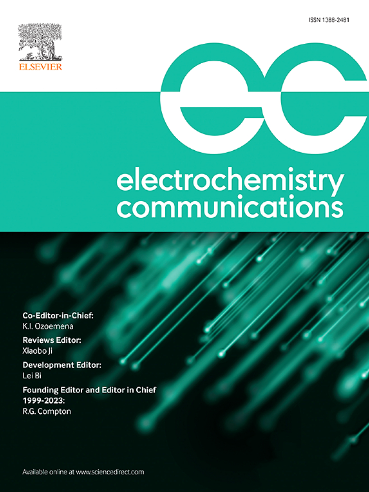炭黑在有序钛纳米管支架上作为下一代高敏感电极的智能纳米工程材料
IF 4.2
3区 工程技术
Q2 ELECTROCHEMISTRY
引用次数: 0
摘要
本研究提出了第一个三电极系统,将氢化二氧化钛纳米管广泛的纳米结构表面与炭黑的电化学特性相结合,开发了具有纳米工程表面的电化学传感器。使用二氧化钛纳米管作为衬底,可以在电极表面沉积高达120 μg / cm2的大量炭黑,而不会观察到其他传感器遇到的不希望的聚集。电化学测量表明,炭黑用量的增加提高了电极的性能,表现出最低的峰间分离(240 mV)和最高的电流密度(1.63 mA cm−2)。电化学阻抗谱分析表明,炭黑修饰的氢化TiO2纳米管电极的电荷转移电阻(52.88 Ω)低于未修饰的电极(12290 Ω)。评价了氢化tio2纳米管电极和优化后的炭黑修饰电极对模型分析物肾上腺素、去甲肾上腺素、苯醌、儿茶酚、抗坏血酸和咖啡酸的检测性能。结果表明,通过将炭黑集成到tio2纳米管结构上,提高了检测能力,从而改善了电化学响应。在炭黑修饰工作电极表面之前,通过对电化学表面进行工程改造,为开发高灵敏度电化学传感器开辟了新的可能性。本文章由计算机程序翻译,如有差异,请以英文原文为准。
Carbon black on ordered scaffold of titania nanotubes as smart nanoengineered material for the next generation of highly sensitive electrode
This study presents the first three-electrode system, which combines the extensive nanostructured surface of hydrogenated TiO₂ nanotubes and the electrochemical properties of carbon black to develop an electrochemical sensor with a nanoengineered surface. The use of TiO₂ nanotubes as a substrate allowed for the deposition of a high amount of carbon black up to 120 μg per cm2 on the electrode surface without observing an undesired aggregation encountered in the case of other sensors. Electrochemical measurements revealed that the increase of carbon black amount improved electrode performance, showing the lowest peak-to-peak separation (240 mV) and the highest current density (1.63 mA cm−2). Electrochemical impedance spectroscopy demonstrated that the carbon black-modified hydrogenated TiO2 nanotube electrode exhibited lower charge transfer resistance (52.88 Ω) than the unmodified electrode (12,290 Ω). The performance of both the hydrogenated TiO₂ nanotube electrode and the optimized carbon black modified-electrode was evaluated for the detection of model analytes namely epinephrine, norepinephrine, benzoquinone, catechol, ascorbic acid, and caffeic acid. The results demonstrated an improved electrochemical response, emphasizing the enhanced detection capabilities achieved by integrating carbon black on the TiO₂ nanotube structure. This modification opens new possibilities for the development of highly sensitive electrochemical sensors by engineering the electrochemical surface before the modification of the working electrode surface with carbon black.
求助全文
通过发布文献求助,成功后即可免费获取论文全文。
去求助
来源期刊

Electrochemistry Communications
工程技术-电化学
CiteScore
8.50
自引率
3.70%
发文量
160
审稿时长
1.2 months
期刊介绍:
Electrochemistry Communications is an open access journal providing fast dissemination of short communications, full communications and mini reviews covering the whole field of electrochemistry which merit urgent publication. Short communications are limited to a maximum of 20,000 characters (including spaces) while full communications and mini reviews are limited to 25,000 characters (including spaces). Supplementary information is permitted for full communications and mini reviews but not for short communications. We aim to be the fastest journal in electrochemistry for these types of papers.
 求助内容:
求助内容: 应助结果提醒方式:
应助结果提醒方式:


